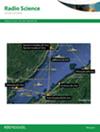Burj Khalifa-inspired reconfigurable microstrip patch antenna for wireless solutions
IF 1.5
4区 地球科学
Q3 ASTRONOMY & ASTROPHYSICS
引用次数: 0
Abstract
This paper presents a new microstrip patch antenna inspired by the iconic Burj Khalifa, Dubai's world's tallest skyscraper. The antenna design focuses on being compact, lightweight, cost-effective, and versatile. Simulated through HFSS software, the patch antenna demonstrates a multi-frequency operation. Fabricated on a double-sided copper FR4 epoxy PCB (4 × 8 cm2, 1.6 mm thickness) using a coaxial probe feeding method, it achieves a gain exceeding 7 dB at 7 GHz. Prototypes show excellent consistency between measured and simulated reflection coefficients and gains at 4.8, 5.7, and 7 GHz. Two additional designs are presented to adjust the resonance frequency, making it suitable for biomedical sensors, WIFI, and point-to-point microwave links. One design involves adding a short slot that is close to the feed point, while the other design includes a pair of varactors. Both designs create a reconfigurable microstrip antenna with electromagnetic characteristics that can be adjusted to increase its electrical length. The antenna resonates at 4.8 GHz. The slotted short patch shifts the resonance to 3.1 GHz, and the varactor patch shifts the resonance frequency to 2.1 GHz. When the DC reverse bias voltage of the varactors varies from 0 to 6 V, the gain improves to 15.2 dB.受哈利法塔启发的可重构微带贴片天线,用于无线解决方案
本文提出了一种新的微带贴片天线,灵感来自迪拜标志性的世界最高摩天大楼哈利法塔。天线设计的重点是紧凑、轻便、经济、多用途。通过HFSS软件仿真,该贴片天线具有多频工作特性。采用同轴探针馈送方式,在4 × 8 cm2, 1.6 mm厚的双面FR4环氧铜PCB板上制作,在7 GHz时获得超过7 dB的增益。在4.8 GHz、5.7 GHz和7 GHz的反射系数和增益方面,原型显示了测量值和模拟值之间的良好一致性。提出了另外两种设计来调整共振频率,使其适用于生物医学传感器、WIFI和点对点微波链路。一种设计包括增加一个靠近馈电点的短槽,而另一种设计包括一对变容器。这两种设计都创建了具有电磁特性的可重构微带天线,可以调整以增加其电气长度。天线的谐振频率为4.8 GHz。开槽短贴片将谐振频率移至3.1 GHz,变容贴片将谐振频率移至2.1 GHz。当变容管的直流反向偏置电压在0 ~ 6 V范围内变化时,增益提高到15.2 dB。
本文章由计算机程序翻译,如有差异,请以英文原文为准。
求助全文
约1分钟内获得全文
求助全文
来源期刊

Radio Science
工程技术-地球化学与地球物理
CiteScore
3.30
自引率
12.50%
发文量
112
审稿时长
1 months
期刊介绍:
Radio Science (RDS) publishes original scientific contributions on radio-frequency electromagnetic-propagation and its applications. Contributions covering measurement, modelling, prediction and forecasting techniques pertinent to fields and waves - including antennas, signals and systems, the terrestrial and space environment and radio propagation problems in radio astronomy - are welcome. Contributions may address propagation through, interaction with, and remote sensing of structures, geophysical media, plasmas, and materials, as well as the application of radio frequency electromagnetic techniques to remote sensing of the Earth and other bodies in the solar system.
 求助内容:
求助内容: 应助结果提醒方式:
应助结果提醒方式:


